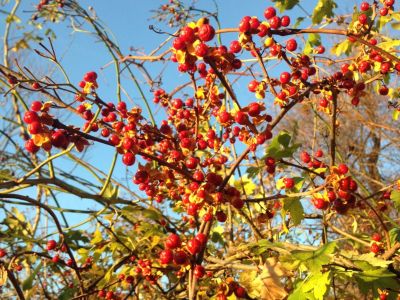Oriental Bittersweet Information
Oriental bittersweet plants are vines that grow up to 60 feet long and can get four inches (10 cm.) in diameter. They are fast-growing and attractive, with light green, finely toothed leaves. The round yellow fruits split to reveal red berries that birds happily devour all winter long. Unfortunately, oriental bittersweet plants have many very effective methods of propagation. The bittersweet plants spread within colonies by seeds and root sprouting. Oriental bittersweet control becomes necessary because the vines also spread to new locations. Birds love the berries and disperse the seeds far and wide. The seeds remain viable for a long time and spout well in low light, so anywhere they fall, they are likely to grow.
Oriental Bittersweet Control
The vines pose an ecological threat since their vigor and size threatens native vegetation at all levels, from the ground to the canopy. When thick masses of oriental bittersweet plants sprawl over shrubs and plants, the dense shade can kill the plants beneath. Oriental bittersweet information suggests that an even greater threat is girdling. Even the tallest trees can be killed by the vines when they girdle the tree, cutting off its own growth. The weight of the dense vines can even uproot a tree. One victim of oriental bittersweet plants is the native variety American bittersweet (Celastrus scandens). This less aggressive vine is being eliminated through competition and hybridization.
How to Eradicate Oriental Bittersweet
Killing oriental bittersweet or even just controlling its spread is difficult, a task of many seasons. Your best bet is not to plant the vine at all nor dispose of live or dead seed-containing material in an area where the seeds may grow. Oriental bittersweet control involves removing or killing oriental bittersweet on your property. Pull out the vines by the roots or repeatedly cut them down, keeping an eye out for suckers. You can also treat the vine with systemic herbicides recommended by your garden store. There are no biological controls currently available for this vine.
